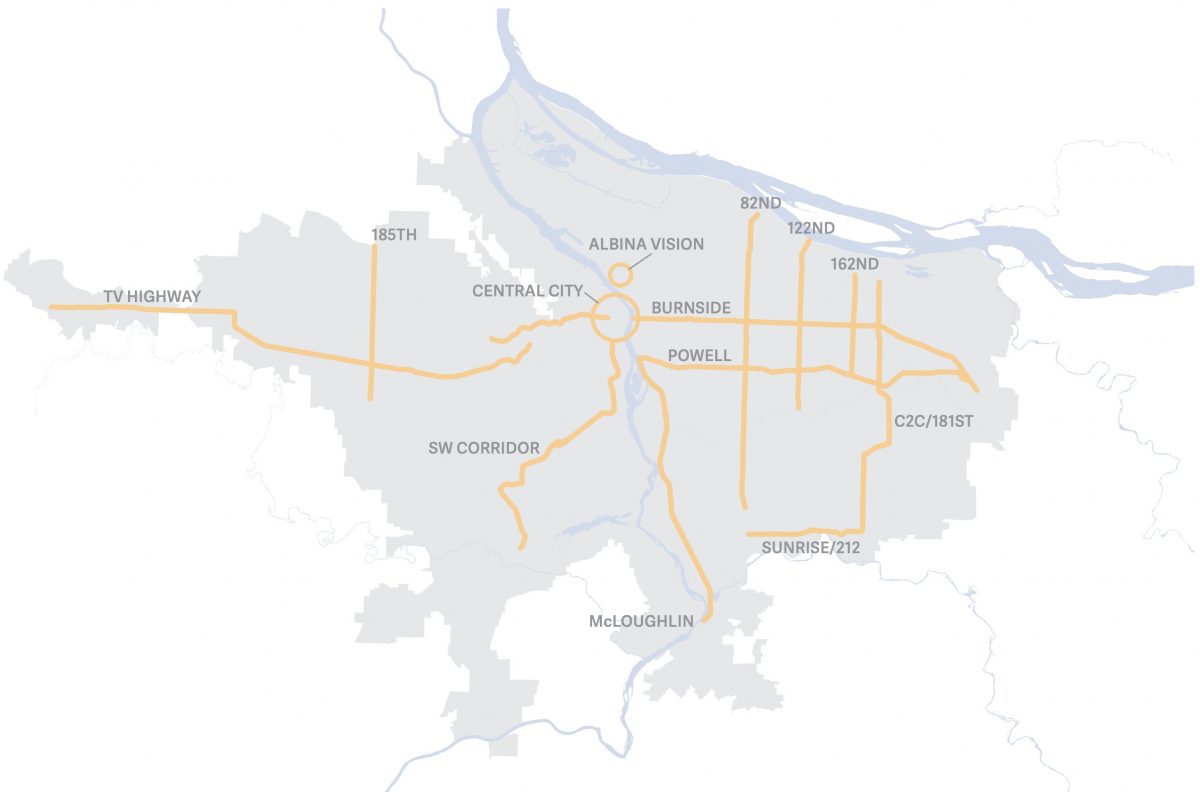
(Source: Metro)
With the holiday break now firmly in the rear view mirror, Metro is returning to work on its planned November 2020 transportation ballot measure with three meetings scheduled for the next week that will give Portlanders a chance to share their opinions about the nearly $4 billion proposal.
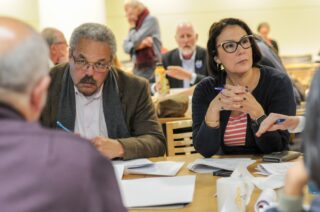
(Photo © J . Maus/BikePortland)
The Getting There Together and other groups are putting out action alerts to contact members of Metro Council in advance of a publich hearing on Monday January 13th, which will see staff and planners take questions from the public about potential funding sources for the measure.
The following day, (Tuesday, January 14th) Metro Council will convene at a work session to consider recommendations from the Transportation Funding Task Force. Then on Wednesday the 15th, the Task Force will meet again for the first time in nearly a month to continue discussions about transportation investment options.
Here’s what you need to know going into what could be a consequential week for transportation funding in our region…
Advertisement
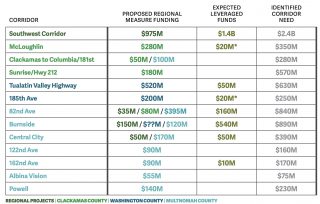
(Source: Metro)
At the beginning of January, the latest recommended measure (PDF) was released by the Task Force. The proposal now calls for $3.8 billion in spending, an increase of $700 million from the last proposal made public in October. In general, the most recent draft provides significant new funding for transit and biking/walking safety improvements and codifies the votes taken at the Task Force’s last meeting on December 18th. According to Metro, 56% of the new overall package of investments are transit-related, while 38% are safety-related and 79% have an equity focus. Further, the measure would create 86 miles of safety investments in high-injury corridors.
The Task Force’s recommendations divvy up the spending between 13 “Tier 1” Corridors, which includes $975 million for the Southwest Corridor Light Rail, a figure that is unchanged from the October draft. But funding in other corridors was increased, sometimes significantly. The Tualatin Valley Highway saw the biggest jump from $350 million to $520 million, with most of the funds going towards improvements for transit users and walkers. The Powell Corridor also saw a significant increase and now has recommended funding at $140 million, up from $30 million, with the vast majority of that also projected to be used for transit and safety.
Advertisement
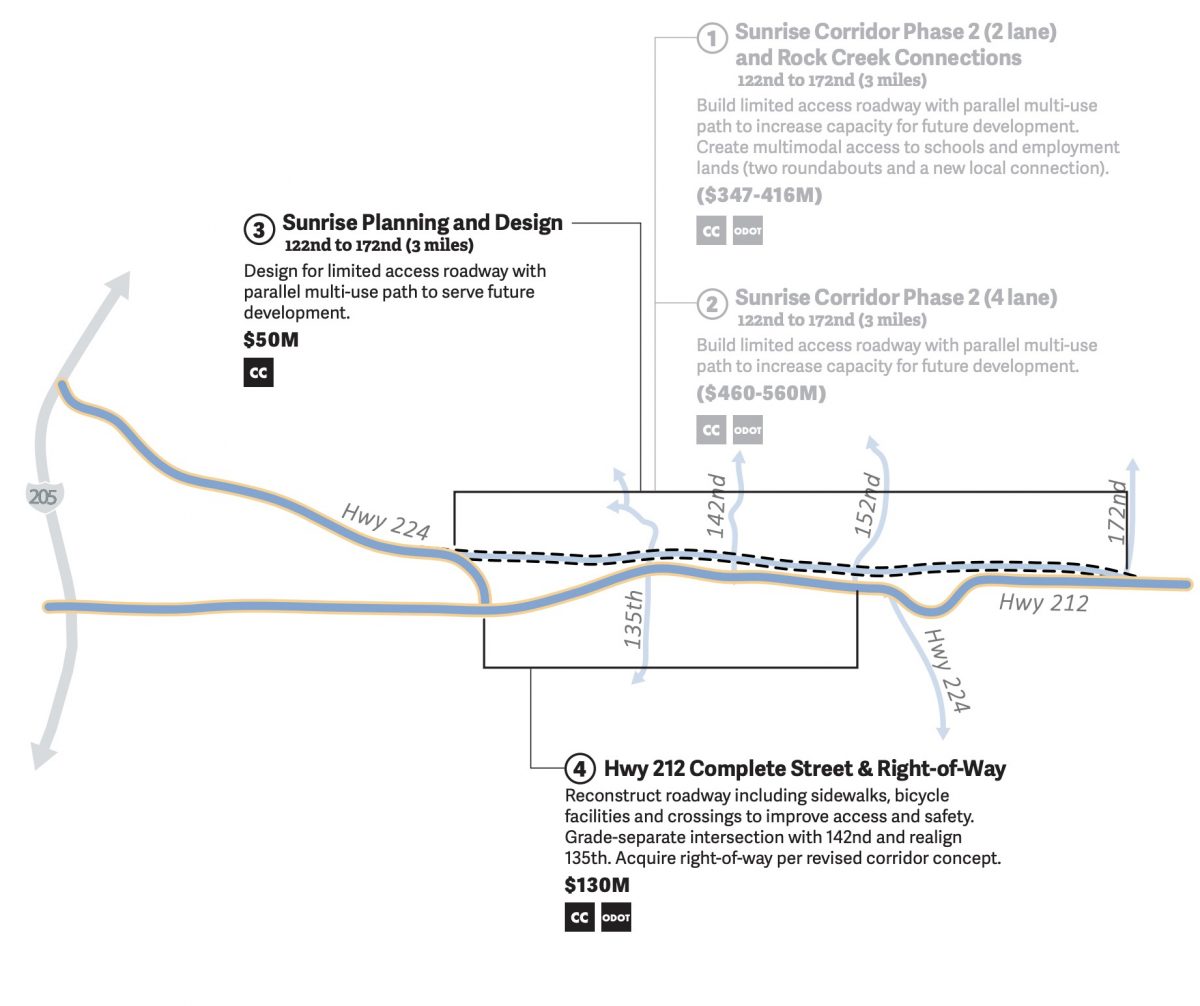
(Source: Metro)
The Sunrise/Highway 212 Corridor, which would see the construction of a new road, did not pass the December 18th vote successfully at first pass. Eventually, a compromise was struck where $110 million in additional funding was committed to non-highway improvements like sidewalks and bicycling facilities along the highway. The construction cost of the new road, which could be another $347 to $560 million, was not funded in the new recommendation and remains to be determined.
The new recommendations for the 82nd Ave Corridor, which includes roadway improvements to the NE Airport Way/NE 82nd intersection, saw $150 million of funding added for bus rapid transit and other safety and transit improvements for a total of $520 million. The Clackamas to Columbia (C2C)/181st Corridor, which would also see the construction of a new road, is now funded at $150 million, with $20 million of that going to enhance TriMet’s 87 bus line.
A significant amount of work is still left to do before the measure is approved by the Metro Council and put before voters in November 2020. The Task Force has meetings scheduled until May. Topics of discussion going forward will include determination of funding for so-called “Tier 2” projects, as well as discussion of how to generate revenue to fund the bond. A poll released in December found a willingness by potential voters to pay for the measure, with possible funding options including new vehicle registration fees, property or income tax increases, or business payroll taxes.
Stay tuned next week for more coverage.
— Ian Edwards @ianedws on Twitter
— Get our headlines delivered to your inbox.
— Support independent community media with a one-time contribution or monthly subscription.



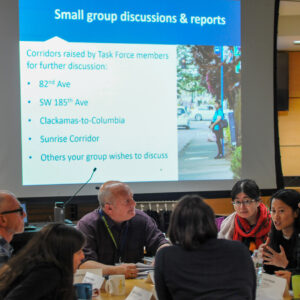
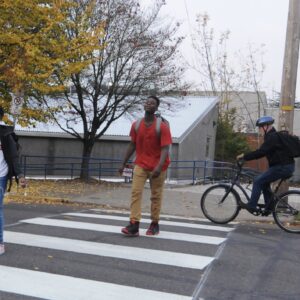
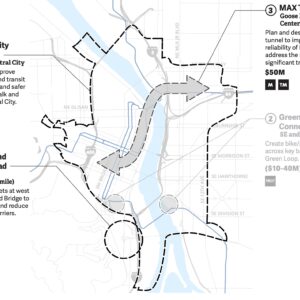
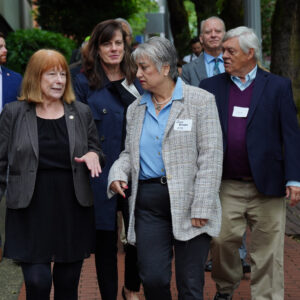
Thanks for reading.
BikePortland has served this community with independent community journalism since 2005. We rely on subscriptions from readers like you to survive. Your financial support is vital in keeping this valuable resource alive and well.
Please subscribe today to strengthen and expand our work.
It’s unsurprising to see that North Portland is once again completely ignored by a governmental agency. I’m sick of paying taxes to subsidize the metros wealthiest residents.
I’ll be working to oppose this ballot measure in 2020.
What is North Portland lacking?
Any protected bike lanes (we have zero past Arbor Lodge), traffic diverters, public transit that can manage a 20 minute trip in less than an hour, lit cross walks, curb builds out to stop the rampant illegal passing on the left, lowered speed limits, traffic enforcement.
It might be easier to catalogue the problems St. Johns doesn’t have with its roads.
They are ;
Metro is looking at much bigger picture stuff than that.
That’s exactly the type of stuff Metro is looking at, they are just looking in the wealthiest communities in the Portland Metro. Lots of safety improvements in their bond measure.
Yes, the region’s wealthy residents of (checks notes) East Portland and Gresham, and those transit-riding bourgeois of outer Barbur and Washington County, are really making out here. I mean, they’ve already got it all!
North Portland and STJ have some obvious needs, and a BRT project on Lombard or similar could certainly be a boon. But c’mon, you think every neighborhood that doesn’t get a project should oppose this thing? These projects are regionally significant, and unfortunately not everyone makes the cut. While there’s lots more to do, we’re hardly ignored up here. Fessenden is finally done. We have a new bollard separated lane (and in some place actual bike track) on Lombard past Pier Park. ODOTs planning a safety project on Lombard in Portsmouth. PBOT is planning a major overhaul of Lombard in downtown STJ. We’ll have a new bridge over Columbia soon…..
I’ll expect to be supporting this measure because it will do a lot of good for a lot of other people. Then I’ll keep looking for ways to get improvements in STJ.
I didn’t realize Tigard was slums? The projects on and east of 82nd are the only projects in the whole package that don’t serve wealthy communities. The lions share of the money is going to server wealthy communities in Northwest, Southwest and inner East Portland.
It’s not that I am opposing it because St. Johns/the peninsula don’t have any projects in here. I am opposing it because the peninsula doesn’t ever have any projects in any bond measure. We are the largest neighborhood in the city and we don’t have a safe ped/bike connection to downtown. I am sick of paying bonds that benefit inner-east siders and the wealthy in NW.
What bond measures are you referring to???
The top 5 neighborhoods in Portland are in terms of population:
– Powellhurst-Gilbert (East Portland) 31,000 people
– Centennial (East Portland) 25,000
– Hazelwood (East Portland) 24,000
– Montevilla (SEUL) 22,000
– Lents (East Portland) 20,000
#6 is St.Johns (North Portland)
Over 30% of the city population lives in the 13 neighborhoods of East Portland and about 28% in SEUL. North Portland accounts for about 15%.
This is why the public process can be so difficult sometimes. People like cmh only care about their small part of the city/world, and can’t understand why resources might be spent elsewhere. I live close to downtown, and fully support the efforts Metro is making in outer-east Portland. This is the part of our metro area that needs the most work.
If you ignore one part of the city over and over again, why would they continue to rubber stamp your bonds? I’m fine with paying for stuff in other parts of the metro, especially in areas East of 80th.
This will be the first safety-related bond I have ever voted against. I am not opposed to this bond specifically for its projects. I am opposed to this bond because Metro has spent the last 30 years ignoring St. Johns. I’m done paying for infrastructure improvements for the wealthy that live downtown and on the central eastside.
It’s unsurprising to me that you support this bond considering you will actually get to enjoy the infrastructure that it produces. PBOT and Metro have been showering your neighborhood with improvement after improvement for a decade, of course you support the bonds that enable that work.
If we all chipped in to buy a cake, and I didn’t get any of it, and then we did it a couple more times, and I still didn’t get a single slice, how long would you expect me to keep chipping in?
Your neck of the woods received a light rail line in 2001, which was extended to the Transit Mall in 2009, and again to Milwaukie (under the name “Orange Line”) in 2015. What exactly are you moaning about?
An all ages, safe connection to anywhere outside of North Portland- Interstate, Greeley, Vancovuer/Williams all have unaddressed, dangerous gaps.
The article references a PDF available in early January that is the latest version of the Metro staff recommendation. Could you please link to this document?
Sorry Evan. My mistake. Here’s the PDF
#nonewroads
ultimately this is a doubling-down on the ‘we can build a lot of stuff’ philosophy of the past 75 years. We need to get more out of our existing infrastructure, not spend big on making more asphalt. I really don’t like the ‘give everyone a piece’ of the pie way that this is being set up. every jurisdiction has something (Sorry NoPo, you’re part of Portland so you got short-changed) that they can take home to their constituents. However, this $4B is money spent primarily on expanding our region’s auto-centric transporation infrastructure which we already can’t afford to maintain. We should be taking space away from cars and giving it to non-auto modes. This is the cheapest & fastest way to reduce car use and improve transit+active transpo infrastructure.
Until we reform how property taxes are assessed – most importantly, until we require that assessed value be reset upon sale – then there is no way I’m voting for this.
Wealthy people in inner NE pay fractional amounts in RE taxes on expensive homes just because they happened to be built over a hundred years ago.
No more blank checks to PPS, Metro, and the other government types lining up at the trough until we think through how these burdens are borne. And even then, $4B for some striping and a light rail system on Barbur seems excessive.
So funding for Metro projects until the State legislature revises state law? While I don’t disagree with you, I’m not sure your means of achieving this change make a lot of sense.
Every single property owner knew that when they purchased. In fact, they likely factored that into the decision to buy.
Didn’t you?
There’s lots of new construction that is boosting the property tax rolls. Low taxes on existing property is one factor that helps increase the sale price, and that money goes back into the economy. Plus, if an older home gets a major construction project it may very well get re assessed. Yes, there are a lot of big fancy homes with lower taxes; there are also a lot of cheap homes with lower taxes. If my duplex got a big re assessment I would pass the costs along to the renters and that is true for a lot of the lower cost real estate around here.
After going through the 20 pages of graphics (the link is provided where it says “According to Metro”…, I’m surprised how much I support this recommendation. The actual breakdown of costs does not look wasteful or directed towards building new, crazy expensive assets that we can’t afford to maintain. There’s very little that goes towards congestion relief – an intersection or lane-widening here or there that seem reasonable given planned growth in those areas. The vast majority goes to fixing and improving existing assets, with a huge focus on speeding up regional bus lines and corridor-level safety of peds and bikes with new off-street paths, protected bike lanes, etc.
There’s no indication of the method of raising these revenues, from what I can tell. All options are still on the table, though I thought the polling already showed that property taxes were less popular. I hope this measure won’t be dependent on property taxes.
I’m agreeing with concerns about North Porfland. I’m also pointing out the major grid of improvement in outer east Portland. This is a huge awesome big deal to this neighborhood. Thank you Metro for listening. However, the major assumption that people are crossing the region and need better access is a hidden assumption of more cars more demand. Every single one of these corridors could be a BRT as a low cost alternative. This is the very painful transition to make. Every single major corridor needs to be gridded with BRT, or no dough. Just like her Honorable and Respectable and kick ass governor did, she required high capacity transit across the CRC. Likewise we should make that assertion across the entire network of major regional corridors. Add high capacity requirements to all corridors and equitably distribute the transition from cars. Also active mode east west connection from North Portland is MEGA important in the interim till we get the new bridge.
I’m all for bikeways—but the suggestions I would propose might make some routes a little longer. I always see these things as a ‘construction problem’ besides the policy and money problem. There are ways to get routes through areas that cars wouldn’t go through anyway. It just takes a little extra effort to figure out how to do it.
Secondly, we are experiencing very high budget demands in transportation due to fears of a Cascadian Subduction earthquake. Multnomah Co. is figuring $1.1 billion…but that will likely go much higher, as these things always do. Yet the OSU/USGS team geologists say that the CSZ is about 130 miles west of here, and we are in the less active middle zone as well. If we saved some of the money that is being spent due to CSZ hysteria we would have it for other needs. We have a $325 million Sellwood bridge project, that could have been done for far less and the traffic diverted out of Sellwood. It’s a danger, and I live two blocks off the street that now is inundated with traffic. Plus schoolkids have to cross it. This was very bad planning, but you couldn’t talk any sense into them—and it was the bike lobby that pushed what we ended up with.
Thirdly, there is no need to resort to expensive formed-in-place concrete for pedestrian and bike overpasses. Engineered and treated wood would be just as good, since they don’t have heavy live loads. And there will be cost effective alloys and polymers in construction. I.E. forget the $10-15 million overpasses!
And final point, where is the added tax revenue from all of the increased real estate density going? Sure, we have more people living here and more demand. But the property tax rolls should also be expanding at the same rate. They said $3.3 billion, and now it is 500 million more? Fuggedaboudit.